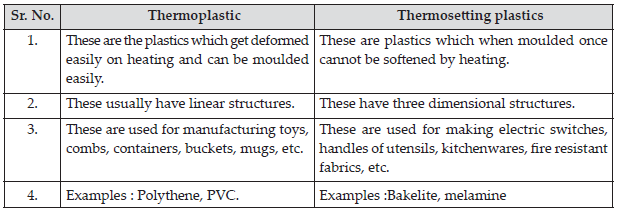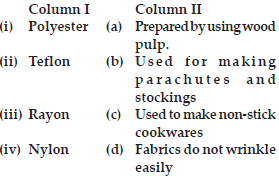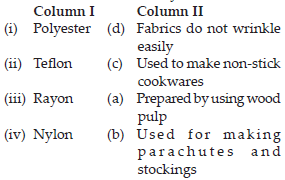Synthetic Fibres and Plastic - NCERT Questions
Explain why some fibres are called synthetic.
SOLUTION:Some fibres like cotton, wool, silk, etc. are obtained from plants or animals, they are thus called natural fibres. Some fibres on the other hand are man-made, i.e., they are either obtained from petrochemicals or are synthetically obtained from natural fibres, thus they do not occur in the nature. Hence, they are called synthetic fibres. e.g. nylon, polyester, rayon, etc.
Q 2.Mark the correct answer.
Rayon is different from synthetic fibres because
(A) it has a silk-like appearance
(B) it is obtained from wood pulp
(C) its fibres can also be woven like those of natural fibres.
(B) Though rayon is a synthetic fibre, it is obtained from natural sources like wood pulp. Since it is obtained by chemical treatment of wood pulp, rayon is a synthetic fibre.
Q 3.Fill in the blanks with appropriate words:
(A) Synthetic fibres are also called ________ or _______.
(B) Synthetic fibres are synthesised from raw material called _________.
(C) Like synthetic fibres, plastic is also a _________.
(A) man-made, artificial
(B) petrochemicals
(C) polymer
Give examples which indicate that nylon fibres are very strong.
SOLUTION:Nylon fibres are used for making parachutes and ropes for climbing.
Q 5.Explain why plastic containers are favoured for storing food.
SOLUTION:Plastic containers seem more convenient than metal containers. This is because of their light weight, lower price, good strength and easy handling. Being lighter as compared to metals, plastics are used in cars, aircrafts and spacecrafts also.
Q 6.Explain the difference between thermoplastic and thermosetting plastics.
SOLUTION: 
Explain why the following are made of thermosetting plastics.
(A) Saucepan handles
(B) Electric plugs/switches/plug boards
(A) The handles of saucepan are made of thermosetting plastic because it is a bad conductor of heat and does not get heated up while cooking.
(B) Electric plugs/switches/plug boards are made up of thermosetting plastic, because it is a bad conductor of electricity. Electric current does not pass through such plastics.
Categorise the materials of the following products into ‘can be recycled’ and ‘cannot be recycled’:
Telephone instruments, plastic toys, cooker handles, carry bags, ball point pens, plastic bowls, plastic covering on electrical wires, plastic chairs, electrical switches.
Can be recycled : Toys, carry bags, plastic bowls, ball point pen, plastic chairs, electric wire covering.
Cannot be recycled : Cooker handles, electric switches, telephone instruments.
Rana wants to buy shirts for summer. Should he buy cotton shirts or shirts made from synthetic material? Advise Rana, giving your reason.
SOLUTION:Rana must buy shirts made of cotton and not one made from synthetic fibres. This is because synthetic fibres absorb less water as compared to natural fibres. Thus, in summers, wearing shirts made from synthetic materials may cause discomfort as they would not absorb sweat and stick to the body, however cotton shirts absorb sweat and dry up faster, thus, making the person feel less hot.
Q 10.Give examples to show that plastics are non-corrosive in nature.
SOLUTION:Plastics are non-corrosive in nature as:
(i) they do not react with any substances.
(ii) plastics do not react with air and water which are essential for corrosion.
(ii) they do not show any chemical reaction.
All the above mentioned properties make plastic useful for storage of various kinds of materials, including chemicals.
Should the handle and bristles of a toothbrush are made of the same material? Explain your answer.
SOLUTION:No, handle and bristles of a toothbrush should not be made of the same materials because handle should be hard while bristles should be made of the soft materials. Bristles should be soft so that it does not harm the gums of teeth. Handle gives the firm grip so it should be made of hard material.
Q 12.‘Avoid plastics as far as possible’. Comment on this advice.
SOLUTION:Avoid the use of plastics as far as possible. Plastics are non-biodegradable materials. So use of plastics is harmful for our environment. The plastics cannot be finally disposed off. Thus, plastics should be avoided as far as possible.
Q 13.Match the terms of column I correctly with the phrases given in column II.


‘Manufacturing synthetic fibres is actually helping conservation of forests’. Comment.
SOLUTION:The natural fibres require raw materials from plants and animals. So they lead to cutting trees and killing of animals. Synthetic fibres are made up of chemicals and these chemicals are not available in forests. So manufacturing synthetic fibres is actually helping conservation of forests.
Q 15.Describe an activity to show that thermosetting plastic is a poor conductor of electricity.
SOLUTION:Refer activity given on page no. 7.